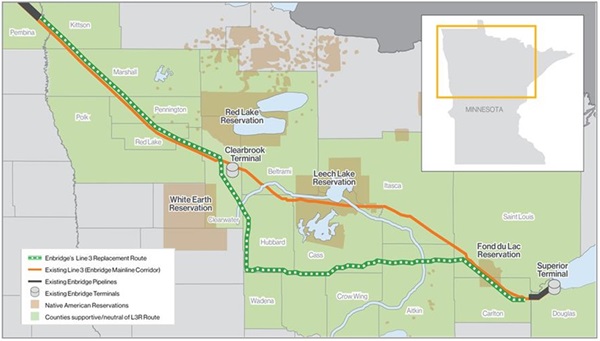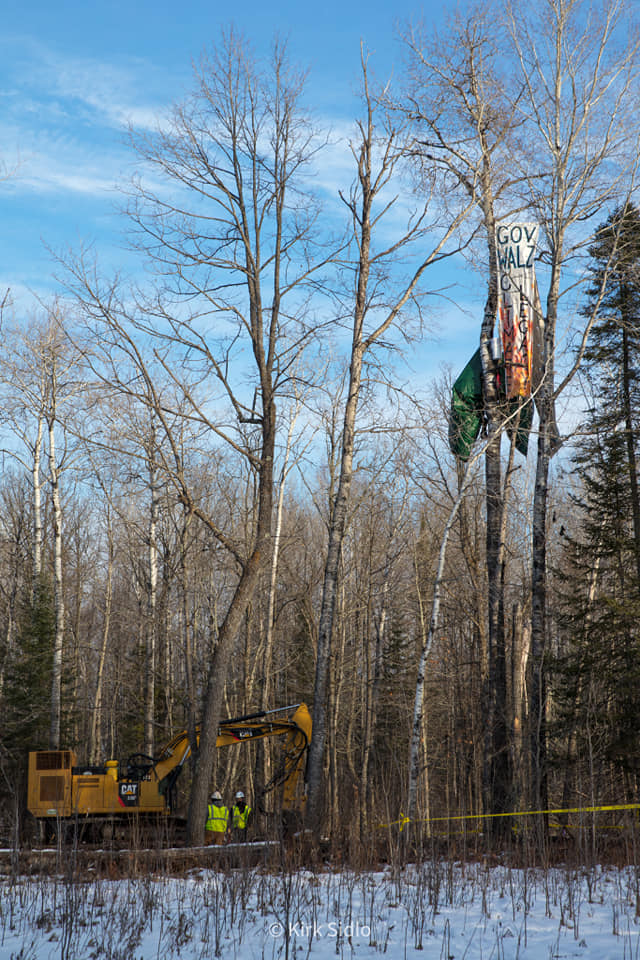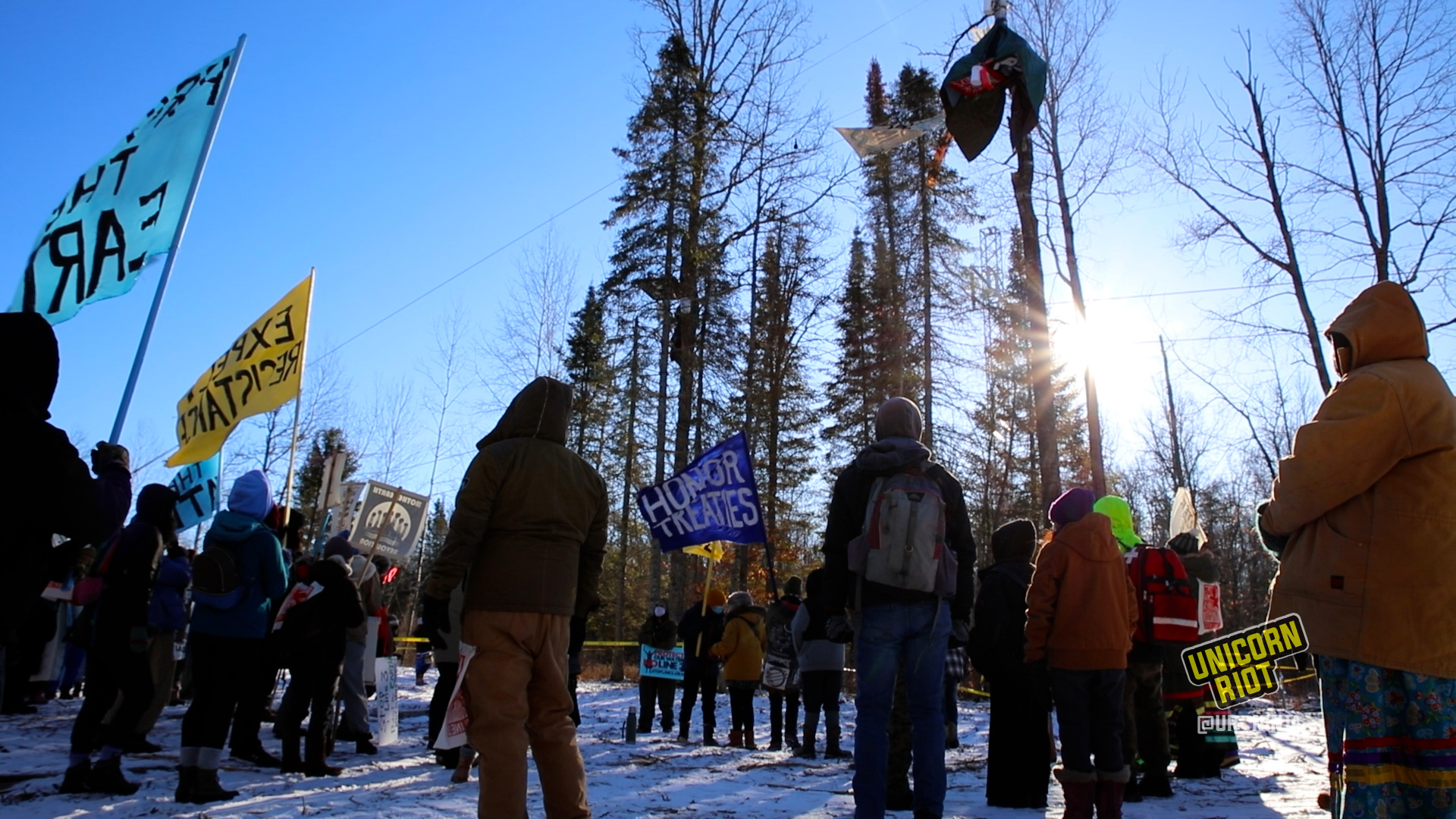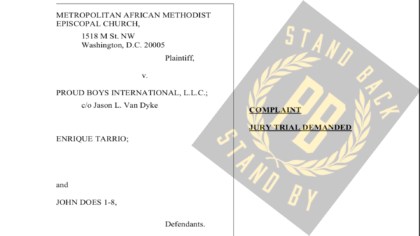Resistance to Line 3: Direct Actions Aim to Stop Construction
Aitkin County, MN – Direct actions aiming to stop the construction of a new replacement Line 3 oil pipeline have escalated as winter settles in. Since the approval of the contentious Line 3 tar sands pipeline on November 30, 2020, there have been numerous actions, such as protesters locking themselves down to construction equipment, blockades of roadways, and an 11-day tree sit.
The pipeline project has faced numerous obstacles over the last few months. Dozens of people have been arrested for protesting, and a new lawsuit has been filed by the Red Lake Band of Chippewa, the White Earth Band of Ojibwe, Sierra Club, Honor the Earth, and Friends of the Headwaters to stop the pipeline. Last month, construction was paused for a few hours in an area of Northern Minnesota when a worker died after being run over with a forklift at a Line 3 work site.
Line 3 is an already existing crude oil pipeline, which transports a particularly dangerous type of oil called tar sands from Alberta, Canada to refineries in Superior, Wisconsin. Owned and operated by Canadian energy company Enbridge, the pipeline was originally built in 1968, running from Edmonton through North Dakota and Minnesota to Superior and has been the source of numerous oil spills. In 1991, Line 3 ruptured and spilled over 1.7 million gallons of oil, making it the largest inland oil spill in U.S. history.
Enbridge is well aware of the potential risks of their infrastructure, particularly when going through bodies of water. In 2014, they proposed the building of a new and larger Line 3, officially titled the Line 3 Replacement Pipeline (L3RP), which would pump even more tar sands oil through Canada and the U.S., making it one of the largest fossil fuel transportation projects in the history of North America.
Enbridge has stated that it’s estimated $2.6 billion “investment in Minnesota’s energy infrastructure” will be used to create thousands of jobs in the state and will produce additional tax revenue. To date, the company has yet to disclose exactly how this investment will benefit Minnesotans nor how much it expects to profit from the Line 3 expansion project.
The current Line 3 pipeline already runs through several Indigenous peoples’ territories, in particular the Leech Lake and Fond du Lac reservations in Minnesota. Leech Lake has declined approval for the new pipeline to be built on their land. In response, Enbridge simply redirected the proposed route to be built south of Leech Lake on the way to Fond du Lac, where Enbridge reached an agreement with the tribal government to build the last portion of the pipeline.

The pipeline also crosses into Indigenous wetlands around Sandy Lake, Minnesota, which was the site of the Sandy Lake Tragedy of 1850, where over 400 Indigenous Anishinaabeg people died during forced relocation at the hands of the U.S. military.
The historical trauma experienced by many Indigenous survivors of this tragedy and others, as well as the consistent treaty violations, have escalated mistrust and resistance to Enbridge’s efforts.
Anishinaabeg peoples continue to occupy and cultivate wild rice on these wetlands, a vital tradition that could be disrupted by potential oil spills from Line 3.
Line 3 Construction in Canada and U.S.
Despite the numerous environmental risks and legal challenges, Enbridge secured legal approval from Canada and every U.S. state that the pipeline runs through. Minnesota was the last to approve the pipeline, granting approval in late-November 2020.
Wisconsin’s 14 miles was completed in 2018 after a very contentious 2017, where direct actions consistently targeted pipeline construction.
In May of 2019, the Canadian leg of the replacement pipeline was finished, upgrading their 34-inch diameter pipeline with a new one of 36 inches along a 665-mile portion; commercial service began in December 2019. Pipeline crews in North Dakota completed construction of a 13-mile stretch of the pipeline last October after starting in August 2020.
Indigenous-led protests and direct actions against Line 3, as well as court challenges, contributed to making Minnesota the last holdout state to approve the pipeline. This all changed on November 12, 2020, when the Minnesota Department of Natural Resources (MN-DNR) and the Minnesota Pollution Control Agency (MPCA) approved various permits for Line 3. Enbridge had already staged pipe segments that have been rusting in the sun on rural roads across Minnesota for the last five years and immediately began construction with those pipes upon receiving state permits.
A week later, the U.S. Army Corps of Engineers’ St. Paul District found the Line 3 pipeline “not being contrary to the public interest,” stating that the project complied with a variety of Acts, including Section 404 of the Clean Water Act. A statement by the Army Corps noted that “while their permit authorizes Enbridge to work within waters protected by the federal government, it does not regulate the siting of the pipeline nor any substance being transported within it.”
The next week, on November 30, the final necessary permit to build the multi-billion dollar project was granted by the MPCA.
7 business days after @MnPCA greenlit Enbridge bulldozing thru 800 wetlands, Trump’s Army Corps approves the final permits.
The pandemic explodes across MN as out-of-state Line 3 workers gear up to head here.
MN Department of Health: 651.201.5000#PandemicPipeline #StopLine3 pic.twitter.com/GIA7LDcqEe
— giniw collective (@GiniwCollective) November 24, 2020
The granting of the final Line 3 permits was a “breathtaking betrayal” to Indigenous communities and the environment, said Louise Erdrich, historical novelist, poet, and member of the Turtle Mountain Band of Chippewa. In her New York Times op-ed entitled ‘Not Just Another Pipeline,’ Erdrich wrote that the pipeline is a “tar sands climate bomb…these Canada-based corporations are perpetrating a vast ecological crime, and Minnesota is their accomplice.“
COVID-19 and Pipeline Worker Safety Failures
As the coronavirus pandemic continues to worsen, some have begun to question why authorities would allow the Canadian oil giant to bring 4,200 out-of-state workers to Northern Minnesota.
A recent study from the University of Texas at Austin suggests that construction workers are 5 times more likely to contract COVID-19 on-the-job than other workers. Despite this, Minnesota defines the construction industry as an “essential service” which can operate during the pandemic under certain safety requirements.
Enbridge has declared that it will fully comply with safety requirements, stating that it has numerous safety protocols in place to limit the spread of infection. It remains to be seen how well these regulations will be enforced considering the remote locations of these new construction sites. It’s also unclear how COVID safety measures could be enforced on pipeline workers who may visit bars and mingle in large groups during their time off of work.
Comments made at a recent McGregor School Board meeting noted their county is a hotspot for new cases and that Enbridge workers have almost all of the current COVID-19 cases in Aitkin County. The number of workers will increase at the end of January and the community is bracing for a possible strain on hospitals.
On December 18, in a Line 3 construction yard in Hill City, Minnesota, a 45-year-old father of nine was run over by a forklift and killed. The man killed, Jorge Lopez Villafuerte, was from Utah, and had been hired by Enbridge contractor Precision Pipeline, LLC. Construction at the site where Villafuerte perished paused briefly, but resumed within a few hours of his death.
Renewed Direct Actions Disrupt Line 3 Construction: A Timeline
After the November approvals in Minnesota, protests and direct actions were immediately organized in opposition to Line 3, aiming to stop or at least delay pipeline construction. One of the first protests after the approval came from one of the institutions that gave the approval, the MPCA, as 12 out of the 17 MPCA advisory group members resigned from their position.
“We cannot continue to legitimize and provide cover for the MPCA’s war on black and brown people,” the advisory group member’s resignation letter stated.
On Saturday, November 14, hundreds of environmental and treaty rights advocates gathered outside Minnesota Governor Tim Walz’s Residence calling on him to say “no” to Line 3.
A few days later, two people locked themselves onto Enbridge excavators being used to construct pump stations in Hubbard County, Minnesota. After shutting down construction for the day while being locked to the equipment, the two water protectors were arrested and jailed overnight.
On November 27, Native American Heritage Day, a water protector chained themselves by the neck to the gates of an Enbridge pipe yard near Backus, Minnesota.
BREAKING: Water protector locks to Enbridge Line 3 pipe yard gate on #BlackFriday! A young person is chained to the gates of fossil fuel giant Enbridge, which seeks to slam a Line 3 tar sands thru Indigenous land in northern MN.
Black Friday falls on #NativeAmericanHeritageDay pic.twitter.com/F4OIP0nBtR
— giniw collective (@GiniwCollective) November 27, 2020
In Cloquet, Minnesota, a prayer walk led by Indigenous women shut down a construction site while carrying out traditional practices such as smudging, making tobacco ties, and praying.
Here with Dawn Goodwin, enrolled tribal of White Earth. “Treaties are the Supreme Law of the Land,” @GovTimWalz – honor the treaties and #StopLine3 NOW #WaterIsLife Palisade MN at the Mississippi River where Enbridge want to put their pipeline through. pic.twitter.com/E5yIVdq0fb
— Honor the Earth (@HonorTheEarth) December 4, 2020
Winona LaDuke, a longtime environmentalist and executive director and co-founder of Honor the Earth, has been fighting against Line 3 for years. On December 5, she was given a citation for praying at her lodge which is near an easement next to the Mississippi River. She stated on Twitter, “I was threatened with arrest for exerting my treaty rights at the Mississippi.. I’m not going to back down to protect the sacred.“
I was threatened with arrest for exerting my treaty rights at the Mississippi.. I’m not going to back down to protect the sacred #WaterisLife #StopLine3 – support @HonorTheEarth and @GiniwCollective https://t.co/RhlFGVqhIg
— WinonaLaDuke (@WinonaLaduke) December 6, 2020
“We need people to have a connection with this Earth so deep that nothing can shake them. Take a stand.”
“Your ancestors are here too. Take a moment to speak to her, our Mother Earth is crying out for the Warriors to rise again. Strong hearts to the front.”
Words of Anishinaabe Warriors relayed in a press release from Indigenous Leaders
Near one of the 22 river crossings where Enbridge plans to bore the oil pipeline underneath rivers, two water protectors started tree-sits in early December. One of the tree-sits stopped active logging in forests by the drill pad on the Mississippi River for 11 days.
All Power to the People!✊🏾
Definitely sending prayers to all who fight blocking Enbridge from putting Line 3 pipeline under the Mississippi River.🙏🏾
Please follow my sister @zhaabowekwe and @GiniwCollective
This is not a game, we must fight! Be brave my family and #StopLine3 https://t.co/B7k4EfgrGr
— Rev Yearwood 🏁 (@RevYearwood) December 5, 2020
In a statement released by the Giniw Collective regarding the tree sits, one of the water protectors who ended up being in the tree-sit for over two weeks, Liam DelMain, said the following:
“Water is not invincible. That’s why I am here. Because Line 3 is a threat to the waters I hold dear, and that we all rely on. This pipeline project is violence. It is violence on the water, and on the people. It is a project that disregards the treaty rights of Indigenous people, accepts the inevitable toxic spills into waterways, and greatly heightens the death toll of the COVID-19 pandemic in local communities. I am here, putting my body on the line, because I have been left with no other choices.“
Liam DelMain, water protector who did 11-day tree sit
Days after the tree-sits went up, others participated in another direct action where they locked themselves to construction machinery.
We won’t back down!
Just because @GovTimWalz has failed to take climate action & disregarded tribal territory doesn’t mean he can’t reverse course. Stop this, now. #StopLine3 #PandemicPipeline pic.twitter.com/yTS9njMiOv
— giniw collective (@GiniwCollective) December 8, 2020
Only a couple days later, two water protectors, Charge and Link, locked themselves to a truck carrying pipes bound for the Willow River crossing. Charge said they were locked to the truck “making sure that they don’t put another piece of piping in to further the genocide of Indigenous people going right through their land.“
Our fight is your fight. Your fight is our fight. Our liberation is your liberation. Your liberation is our liberation. We are in this together.
This is what solidarity looks like ✊🏽❤️#FreePalestine #BlackLivesMatter #DefendTheSacred #StopLine3 pic.twitter.com/qRCd7f573s
— giniw collective (@GiniwCollective) December 11, 2020
Link said that as a Black man he took part in the December 2020 direct action to show intersectional solidarity to the Indigenous community.
“Showing solidarity with my Indigenous family. I identify as African-American / Black. They stood up when we had our uprising [George Floyd], it’s only right to stand in solidarity with them and their misfortunes and oppression as well.
It’s time for solidarity and understanding how all this stuff is intersectional … it’s not just an Indigenous people’s fight, this is all of the oppressed people’s fight. It’s time to take a stand. Stand up to your oppressors and then if you have a neighbor that’s also oppressed, stand with them against their oppressor as well.“
Link, intersectional activist who locked down to construction equipment
The next day in Minneapolis, around two dozen college students went to a Chase Bank location to demand the bank meet with Indigenous women and to defund Line 3. Bank officials declined to meet with them.
Students in Minneapolis deliver letter from Indigenous women to @Chase and read it out loud in the lobby b/c the bank refuses to respond to the women’s request for a meeting.
Read the full letter here: https://t.co/WB7tK5jQ5O #StopLine3 pic.twitter.com/C9n0Qz98Rp
— Resist Line 3 (@ResistLine3) December 12, 2020
Meanwhile in Northern Minnesota, Indigenous women leaders made a call-out for others to show up to protect the Mississippi River as the construction was getting close. Tribal attorney and founder of the Giniw Collective, Tara Houska, said during the call-out, “we need to elevate this struggle and protect the Mississippi.“
On December 14, twenty-two water protectors were arrested and the tree-sit that had been halting construction ended when the police brought in a cherry picker and forced Liam from the tree. The tree was cut down after the tree-sit apparatus was removed.

Those arrested during the action were held overnight; most of them arrested on charges of trespassing on the drill pad.
Since the call-out for water protectors, hundreds of people have showed up to the area of Palisade, Minnesota, to resistance encampments and front lines of the struggle to stop Line 3. Religious leaders and elected officials have joined the resistance as well, facing threats of arrest numerous times while visiting pipeline sites.
Via #StopLine3.org “The People are Rising like the Water,” and the Anishinaabe people prohibit this pipeline Line3 in the 1855 Treaty Land. We ask @JoeBiden @KamalaHarris to intervene with MN @GovTimWalz to #StopLine3 NOW before Enbridge injects their line into our Mississippi + pic.twitter.com/TlmxjYTadQ
— Honor the Earth (@HonorTheEarth) December 16, 2020
“It’s our obligation to #HonorTheTreaties. Until the [appeals] process has gone all the way through the courts, we need a stay.”
MN legislators & citizens coming together to urge @GovTimWalz to fully respect MN’s Native Nations. #MNLeg #StopLine3 #RISECoalition @HonorTheEarth pic.twitter.com/Gk0uxVpxbF
— MN350 (@MN_350) December 15, 2020
I’m excited to be part of an incoming class that cares so much about Environmental justice issues and are dedicated to #ProtectMotherEarth #StopLine3 @HonorTheEarth https://t.co/JtrU9Eh7KI https://t.co/qyEBITyIJH
— Heather Keeler for House 4A (@Heather4House) December 21, 2020
It’s incumbent upon us to fight the continued trauma inflicted on Mother Earth. Thx to Rep-Elect @HeatherKeeler18 for inviting us into this sacred space & to @WinonaLaduke for sharing your knowledge & wisdom. An honor to stand with water protectors in Palisade, MN today. pic.twitter.com/ttcuGA3uAv
— Kaohly Vang Her (@KaohlyVangHer) December 21, 2020
Officers from Minnesota’s Department of Natural Resources, deputies from the Aitkin County Sheriff’s Office, and private security patrol the pipeline construction routes. Since the DNR gave Winona LaDuke the citation for praying in her lodge, there have been times they’ve denied Indigenous residents access to the prayer lodges and other sacred sites along the construction route.
On December 21, reindeer puppets and a large constructed black bear celebrated Winter Solstice with dozens of water protectors near pipeline construction.
“They’re [Enbridge] eating through the forest right now. They’re almost at several different river crossings … We shouldn’t have to destroy our environment to live,” said Tara Houska in a late-December video released on Facebook by Stop Line 3. The video, created by Sarah LittleRedfeather, also featured two prominent Indigenous activists, Winona LaDuke and Ogichidaakwe Tania Aubid.
On December 28, water protectors erected a 30-foot-tall tripod in the front of an Enbridge pipe yard in Backus, Minnesota. Emma Harrison ascended to the middle of the tripod while dozens of supporters surrounded the space.
“I’m part of the Line 3 resistance movement because this pipeline embodies everything I believe is wrong with the world. Profits for a few over the well-being of all communities near and far, present and future. Stopping Line 3 is a tangible way to fight for the world I want to live in.“
Emma Harrison, water protector who blockaded pipe-yard
Tripods with a person locking down on top of the three poles have long been used in environmental movements across the globe as a civil disobedience tactic. The tripod itself is one of the oldest design structures on the North American continent.
BREAKING: Water Protector Arrested After Blockading Enbridge Line 3 Pipe-yard until 2pm.
This action is just 9 days after an Enbridge worker was killed at a Line 3 workyard, Enbridge has yet to comment on its unsafe practices. We’re standing up for your water, your health also. pic.twitter.com/pM8Lr09isq
— giniw collective (@GiniwCollective) December 28, 2020
After hours of halting construction by hanging from the tripod, Harrison was eventually taken down with a cherry picker and arrested in a precarious scene as authorities first attempted to cut the tripod while she was still hanging from it.
While live-streaming just yards from the tripod, Tara Houska said that police were showing an “obvious disregard for human life” by “risking [Emma’s] safety, risking her life.“
“She could get really, really hurt. They just said that there’s an ambulance standing by. That’s their plan. Rather than pulling her out more safely, they do not seem to care, and they want to do it the quickest, fastest, cheapest way possible. Obvious disregard for human life, as Enbridge has already shown their obvious disregard for human life when they paused work for just a couple hours last week when one of their own workers was killed. That’s who we’re dealing with. That’s the kind of concern for human life that we’re dealing with.”
Tara Houska, while streaming police attempt to cut down water protector from tripod on December 28, 2020
Two blockades were erected ten miles apart on a road into the wetlands in Savanna State Forest on January 5, blocking access to a Line 3 construction site. One blockade featured the shell of a car that was sawed through in the passenger side with a person arm-locked into the car. The other featured several people with their arms locked into large concrete barrels.
On Saturday, January 9, hundreds of water protectors took part in a day of action and prayer. Several construction areas were occupied, halting the work day. Seven people were arrested and charged with trespass on critical infrastructure, a gross misdemeanor, near Hill City, Minnesota. One person was also charged with unlawful assembly.
Earlier today, people gathered near Palisade, MN to protest the construction of Enbridge’s Line 3 pipeline. Led by Native community members, folks marched down the Great River Road to where the pipeline is being built. @MPRnews pic.twitter.com/YkKES665Co
— Ben Hovland (@benjovland) January 9, 2021
Despite the winter and cold temperatures, Enbridge is working fast to complete the Minnesota stretch of the pipeline. County sheriffs are acting as security for the pipeline, and as part of Minnesota’s Northern Lights Task Force, they’ve been training for anti-pipeline protests with other agencies including Minnesota’s Department of Public Safety, Enbridge security, and a private police foundation. Training exercises for protecting pipelines from protesters have been held at military bases in Minnesota since 2018.
As Indigenous-led resistance to Line 3 in Northern Minnesota continues, they voice grievances regarding out-of-state workers potentially bringing the coronavirus to Minnesota, centuries of broken treaties, the dangers of man camps to Indigenous women, and environmental degradation to their lands. Despite years of delay, numerous lawsuits, and a recent workplace death during construction, Enbridge readies to bore underneath the Mississippi River, which water protectors say threatens wild rice and the water supply of millions downstream.
Many are waiting to see how the incoming Biden administration intends to handle this issue, considering he will have the executive power to halt construction of Line 3. Biden has previously voiced opposition to another tar sands pipeline, the Keystone XL project, and is being called upon by water protectors to put an end to all pipeline projects in the area.
Enbridge says it intends to have the Line 3 project in Minnesota completed by the end of 2021.
Cover image contributed by Kirk Sidlo.
[Updates made January 12, 2021: We reported incorrectly that Tara Houska was “co-founder” of Giniw Collective. That has been changed to show she is the “founder”. We updated this paragraph to include how long the pipes have been sitting outside: Enbridge had already staged pipe segments that have been rusting in the sun on rural roads across Minnesota for the last five years and immediately began construction with those pipes upon receiving state permits. We added this paragraph: Comments made at a recent McGregor School Board meeting noted their county is a hotspot for new cases and that Enbridge workers have almost all of the current COVID-19 cases in Aitkin County. The number of workers will increase at the end of January and the community is bracing for a possible strain on hospitals.]
Follow us on X (aka Twitter), Facebook, YouTube, Vimeo, Instagram, Mastodon, Threads, BlueSky and Patreon.
Unicorn Riot's Line 3 Oil Pipeline Coverage:
- Landing Page for all Unicorn Riot Line 3 Resistance Coverage
- Minnesota Attorney General Keith Ellison Speech Disrupted by Water Protectors - October 8, 2021
- Over 50 Line 3 Pipeline Protesters Arrested Outside MN Governor’s Residence - September 22, 2021
- Police Break Up Ceremony and Indigenous-Led #StopLine3 Occupation - August 31, 2021
- Hundreds March from Governor Residence, Urge Chase Bank Defund Line 3 - August 31, 2021
- First Trial from Treaty People Gathering Ends in Acquittal - August 23, 2021
- Line 3 Opponent Sentenced to Thirty Days in Jail - August 19, 2021
- Enbridge Spills 10,000 Gallons of Line 3 Drilling Fluid - August 16, 2021
- Line 3 Fusion Center Data Declared Secret - August 4, 2021
- Judge Orders Sheriff to Halt Harassment of Line 3 Resistance Camp - July 24, 2021
- Water Protectors Occupy Work Sites and Lock Down to Line 3 Pipeline Construction - July 1, 2021
- Hubbard County Barricades Private Property, Imprisons Water Protectors - June 28, 2021
- Indigenous-Led Blockades Occupy Line 3 Pipeline Sites - June 10, 2021
- Rising Up to the Heat: ‘Treaty People Gathering’ Resists Line 3 Pipeline - June 7, 2021
- Activists Serve Denver Wells Fargo Eviction Notice - May 3, 2021
- Appealing Line 3 Pipeline: Supply and Demand at Root of Hearing - March 23, 2021
- Caravan Disrupts Line 3 Construction Routes, Carlton County Triggers Backlash - March 13, 2021
- Treaty Rights Asserted During Creation of White Earth Camp - March 13, 2021
- 70 Water Protectors Cited, 1 Arrested During Line 3 Commemorative Rally - March 4, 2021
- Bipod and Car Blockade Jam Up Line 3 Construction - March 2, 2021
- Three Lock Down Inside Line 3 Pipeline For 6+ Hours - Feb. 21, 2021
- Lockdown to Keep it in the Ground: Line 3 Resistance - Feb. 15, 2021
- Court of Appeals Denies Motion to Stop Line 3 - Feb. 3, 2021
- Opposition to Line 3 Mounts - Jan. 29, 2021
- Resistance to Line 3: Direct Actions Aim to Stop Construction - Jan. 11, 2021
- Enbridge Line 3 Construction Blocked by Activists in Northern Minnesota - Nov. 18, 2020
- Protests After Permits for Line 3 Oil Pipeline Approved - Nov. 17, 2020
- ‘No KKKops, No Pipelines’ Banner Dropped in Minneapolis - Oct. 6, 2020
- “Divest from Climate Change!” Chase Bank Branch Protested on Opening Day - Nov. 7, 2019
- March to Protect The Sacred on Indigenous People’s Day 2019 - Oct. 14, 2019
- Hundreds Rally in Opposition to Line 3 Tar Sands Pipeline in Minnesota - Sept. 28, 2019
- Direct Action in Minnesota as Line 3 Pipeline Approval Reversed - June 3, 2019
- Multi-Agency Task Force Prepares “Rules of Engagement” For Line 3 Protests - Feb. 11, 2019
- ‘Valve Turners’ Shut Down Enbridge Oil Pipelines in Minnesota - Feb. 4, 2019
- Arts, Culture, and Hip Hop Resist Line 3 as Lawsuits Against Approval Continue - Dec. 29, 2018
- Minnesota Police Train at Military Base as Line 3 Pipeline Protests Escalate - Oct. 25, 2018
- Judge Accepts Water Protectors’ Climate Change Necessity Defense - July 18, 2018
- Line 3 Oil Pipeline Approved By Minnesota Regulators - June 28, 2018
- As Line 3 Oil Pipeline Decision Looms, Indigenous Resistance Increases - June 26, 2018
- Interfaith Community Delivers Letter of Line 3 Opposition to Minnesota Government Offices - June 4, 2018
- Minnesota Public Utilities Commission Requests Line 3 Schedule Change - Jan. 10, 2018
- Rally Against Line 3 Minnesota Pipe Yards - Dec. 11, 2017
- Resistance to Line 3 Pipeline Seeks to Save Sacred Manoomin - Oct. 9, 2017
- Direct Action Ramps Up Resistance to Line 3 - Sept. 18, 2017
Please consider a tax-deductible donation to help sustain our horizontally-organized, non-profit media organization:



